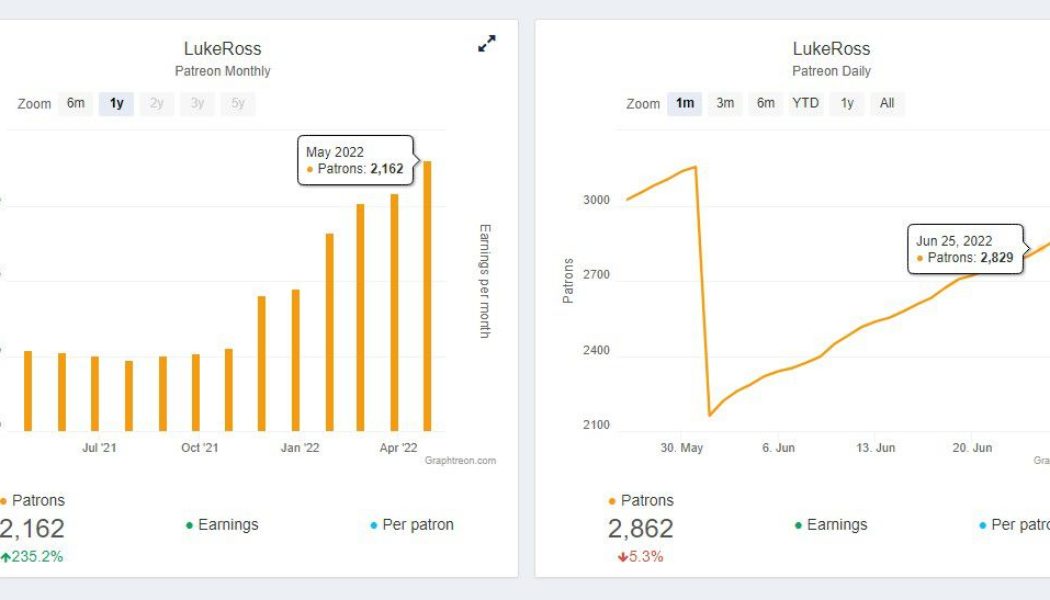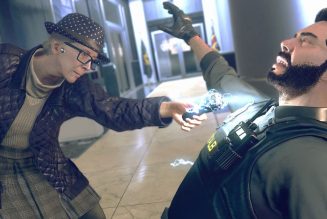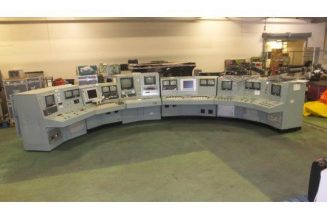Luke Ross* has a hard time telling friends what he does for a living. He can’t quite believe it himself. “I’m a kid with a fake steering wheel in the backseat who pretends to know where they’re going,” he tells The Verge. In 2020, he released a free mod for one of the most popular video games, Grand Theft Auto V, that lets you play the entire game in VR. Now, thousands of people pay him every month to stick their heads into some of their favorite video game worlds.
Today, he currently makes over $20,000 a month modding PC games like Elden Ring, Red Dead Redemption 2, and Horizon Zero Dawn to run in VR headsets instead of the traditional monitors and TVs they were designed for. Every one of his Patreon backers signs up for a $10 monthly fee, and — incredibly — he says two-thirds of them stick around.
He suspects that’s because they aren’t just there to buy his mods. They’re also supporting his mission to show the video game industry that it’s got VR all wrong.
*Luke isn’t his real name; he agreed to speak to The Verge on the condition we wouldn’t reveal personally identifying information. “I want to be judged for the quality of my work and what I put out, not for how I look or sound.”
“Poisoning the well.” I remember hearing that phrase a lot back when the Oculus Rift was new — it’s what they said behind closed doors when devs brought games to virtual reality without designing them to keep players from throwing up. VR startups and VR enthusiasts were deathly afraid a bad first impression would cause people to write off VR entirely before it could reach its potential.
For the most part — I’m looking at you, Resident Evil 7 — that fear didn’t come to pass because the video game industry played ball. Some invested in games with full-body movement and motion controllers; one helpful tip to prevent simulator sickness is to let you turn naturally instead of flicking a joystick to jerk your virtual head around. Most companies also drastically reduced the graphical fidelity of games they brought to VR so they wouldn’t require a powerful, expensive PC. For fluid comfort, VR games have to deliver high-resolution images for each of your eyes — and that has meant a trade-off in fidelity. It’s why most VR titles look like they’d be at home on a Nintendo Wii. In general, instead of blindly bringing their big-name games to VR, they stuck to bite-size “experiences” or made small original titles that, it’s probably safe to say, didn’t bring them the returns they hoped.
Luke thinks those efforts were misguided. He worries VR is still in danger of becoming a passing fad because the common wisdom of how to build VR games is pushing game studios away.
He believes his popular Patreon is proof that there’s an easier way. If a single man can make Grand Theft Auto V or Elden Ring playable in VR, doesn’t that mean these companies are leaving money on the table? “It’s an incomplete experience,” he says, “but it’s enough to make a lot of gamers understand that this should be the future of gaming.”
[embedded content]
One evening, I fire up Elden Ring with the Luke Ross mod. It’s remarkably simple to install — drop a compressed folder of files into my game director, run the script, then launch it from Steam like usual. It handles most everything else, automatically detecting my Quest 2 headset (even though I’m streaming wirelessly from my PC) and setting refresh rates and resolution appropriately.
Suddenly, I’m inside Elden Ring, looking up at the game’s incredible underground kingdom filled with its impossible sky of stars. I’m exactly where I left off in the game, only now I’m there. Every direction I turn, it’s all around me in its shimmering, ethereal glory. Suddenly, staring up at the golden Erdtree for eternity, I understand why I keep finding dead lords perched in thrones across the game’s cliffs and shores. This world is beautiful. And I find myself with a newfound passion to explore it.
My passion lasts about 30 seconds. As soon as I move my character, the scenery shakes slightly. The first twinge of sickness begins when I try to turn my shining armored knight around with my gamepad’s joystick controls. When I teleport to a dungeon and try a few simple fights, I find the game simply doesn’t run fast enough to maintain smooth frame rate in VR, even on my moderately capable gaming PC with a 3060 Ti. I break out in a sweat, a clear signal it’s past time to quit. I feel sick the rest of the night.
I don’t always get sick in VR! I’ve played Resident Evil 4 VR, Space Pirate Trainer, Firewall: Zero Hour, and Half-Life: Alyx for hours on end. But I’ve also had plenty of bad experiences in titles without the extensive guardrails those made-for-VR games offer. When I covered the industry in the early days of The Verge, I got used to trying new demos late at night so I wouldn’t have to suffer long if things went south. I’ve learned that I’m particularly sensitive to games that point me in a direction I’m not pointed in the real world; I can also easily get sick while reading in a car.
I’m afraid to say that every Luke Ross mod I’ve tried triggers me, even his original one for 2002’s No One Lives Forever 2, a game so old it runs like butter on a modern PC. (I did last almost an hour there.) But my experience doesn’t make me angry or worried for VR. Instead, I’m jealous that Luke’s backers can experience these games from the inside, curious if I can finally get my own VR legs under me, and utterly fascinated that Luke can make a living this way.
Luke considers himself lucky: he didn’t need to quit his day job to become the 41st most popular Patreon in the games category and secure a substantial income. He just needed to press pause. As a freelance software engineer (he agreed to speak to The Verge on the condition we wouldn’t reveal personally identifying info like his name, location, or former employers), he was already used to sporadic income, and he already worked from home. One day, he simply decided to stop taking on new projects and see if the VR community would support him instead.
It probably helped that, by the time he launched the Patreon in May 2021, he was already reasonably well-known. After major gaming sites like Kotaku and our sister site Polygon covered the free release of his Grand Theft Auto V mod on GitHub in 2020, he saw 200,000 downloads. And while only around 600 people initially signed up for his Patreon last year to try Red Dead Redemption 2 and the Mafia trilogy, that following nearly doubled after he added Horizon Zero Dawn and doubled again after Cyberpunk 2077 and Elden Ring. He says he went from making “a bit less than I used to make” as a software engineer to earning much more — at least for now.
:no_upscale()/cdn.vox-cdn.com/uploads/chorus_asset/file/23663837/luke_ross_patreon.jpg)
On the downside, he also makes it sound like he’s working harder than ever. “In my previous life before I embarked on this Patreon adventure, I had a lot more free time during my day. It’s like two of my day jobs, to be honest.”
But Luke doesn’t spend the bulk of that time figuring out how to hack your head into your games. He spends it fixing tiny things that the original game developers seemingly neglected, like making sure a character’s health bar actually appears over their head instead of at some arbitrary point in space.
“With the framework I’m building, it’s a trivial job of making the camera 3D and attaching it to the movement you’re doing with your headset… in one day or two, the mod would be out if I would have limited myself to that. Then comes a month of work tweaking all the little things to make the experience actually enjoyable, fully playable, not just something you look at for 10 minutes and then forget like it never existed.”
Then there’s the effort to get his mods working again after a developer patches the game. He estimates that’s another 5 percent of his time right there. “Rockstar updates their games almost weekly, so it’s a huge amount of work,” he says. Elden Ring broke compatibility at least once while I was researching this story, too.
:no_upscale()/cdn.vox-cdn.com/uploads/chorus_asset/file/23663931/akrales_161109_1266_A_0036.0.jpg)
It’s important to note that Luke isn’t doing anything particularly groundbreaking from a technical perspective. If you don’t care about guardrails, turning a 3D game into a VR one isn’t exactly rocket science. Here’s a gross oversimplification that knowledgeable readers will probably hate: when you play any modern 3D game on a flat-screen, you are a cameraperson inside a giant film set created by the 3D engine. That engine lets you point a single camera in any direction you’d like to look with your joystick or mouse and stream that rectangular image to your rectangular screen.
But say you had two cameras, one for each eye: you’d have stereo 3D. For VR, simply turn those cameras to point exactly where your head is pointing by monitoring the 3D coordinates of a motion-tracked headset.
The stereo 3D community has known the basic tenets for years, and Luke didn’t come out of nowhere; he tells me he was part of that scene, an early adopter of Nvidia’s long-discontinued 3D Vision glasses. His first mod was a simple crosshair for No One Lives Forever 2 that placed it at the correct depth for 3D. He frequented the MTBS3D forums where a young Palmer Luckey first crowdfunded the Oculus Rift, and it was Luke’s dissatisfaction with existing 3D to VR conversion software like Vireio Perception and the still-popular VorpX that pushed him to create his own GTA V mod.
:no_upscale()/cdn.vox-cdn.com/uploads/chorus_asset/file/23663992/3D_Vision_2_image5.jpg)
And from there, Luke freely admits, he’s been standing on the shoulders of giants. The GTA V mod was based on 3Dmigoto, a tool developed by the Nvidia 3D Vision community, and he says he’s grateful for everything he learned and the games they let him play. For later mods, he credits crosire, the developer of the ReShade tool that lets modders inject shaders into existing DirectX, OpenGL, and Vulkan games. “Most of the work was heavily modding ReShade itself to convert it into a framework so it can do VR and growing the hooking and injection system,” he says.
But it’s hard not to credit Luke with a sense of renewed excitement in 3D to VR conversions, and I suspect it’s thanks to the additional techniques and features he’s laid atop that framework. His mods now let you slow down or even freeze time so you have time to think and react and tweak settings should things be too overwhelming now that a game that’s designed to be in front of you exists all around you instead. Some also have a mode that lets you freely explore the worlds without fighting any enemies at all, which I plan to try at length after I finally beat Elden Ring on my flat-screen.
Perhaps most importantly, there’s the controversial trick that lets Luke offer VR with such demanding games to begin with, a feature he calls “alternate eye rendering,” where his mods double the game’s effective frame rate by not actually using two cameras to produce VR like I described — instead, they rapidly move the camera between what you’d see with your left and right eyes, only drawing one new frame at a time. That’s why my Elden Ring experience suddenly seemed shaky when I started moving even though it was fine just looking around the environment.
“AER is not my choice because I love it but because it’s a necessity,” Luke tells me, pointing out that games like Elden Ring and Cyberpunk 2077 can barely manage a stable 60fps when you’re playing them on a normal screen. “I’d be selling snake oil if I said I could deliver new games by magically making them deliver more frames per second at insanely high resolution,” he adds.
But he admits he’s a little troubled by the paradox he’s seen in his Patreon’s first year. When he chooses to bring games to VR that actually run smoothly, the audience doesn’t seem to care. The Mafia trilogy “runs brilliantly on modern hardware. Basically you get 140fps,” he says, “and it’s the least talked about game in my Patreon. Basically nobody cares about it and everybody cares about Cyberpunk 2077.”
“Games like Elden Ring can actually bring new people to VR,” he adds.
[embedded content]
Luke believes he may have found one happy medium, though: by the time you read this, he’ll have a mod ready for Elden Ring predecessor Dark Souls Remastered that can run at 180fps on a modern graphics card, enough for 90Hz per eye on headsets like the Valve Index and Quest 2. He hopes it’ll be well-received, but either way, he plans to continue a mix of low- and high-performance games to show what VR can do. On the more intensive side of things, he says he’ll absolutely do Marvel’s Spider-Man when it comes to PC and is considering God of War’s impressive PC port as well.
One thing that confuses Luke is that he hasn’t heard from video game developers — not with praise, not with cease-and-desists, not at all. “They totally seem to not care.” He says he’s not really worried because he’s serving a niche of a niche, and he’d happily negotiate or simply take down a mod if they asked.
He does keep possible legal entanglements in mind when he chooses which games to mod, though. He decided not to do the remastered GTA Trilogy in part because Rockstar had already announced that GTA: San Andreas would come to VR, and he was worried lawyers might ask him to remove his GTA V and Red Dead Redemption 2 mods as well. “A game which already has a VR mode on PC would be very low on my list of priorities, also because that’s a very good way to invite a cease-and-desist,” he says. But he wouldn’t necessarily shy away from modding Ace Combat 7, which only ever offered a VR mode on PlayStation 4, omitting it from the PC version of the game.
Luke says he isn’t sure how long his Patreon can truly last and is trying not to take it for granted. But he hopes he’ll get the attention of the games industry sooner than later.
“My hidden agenda is to show the world that even with some technical problems, some artifacts, lacking full physics, lacking motion controls, you can still get most of the way there with a really small effort, a really small investment… it’s my hope that someone sees this, some of the money-movers in the industry and thinks, ‘Okay, that can be done quite easily.’”









